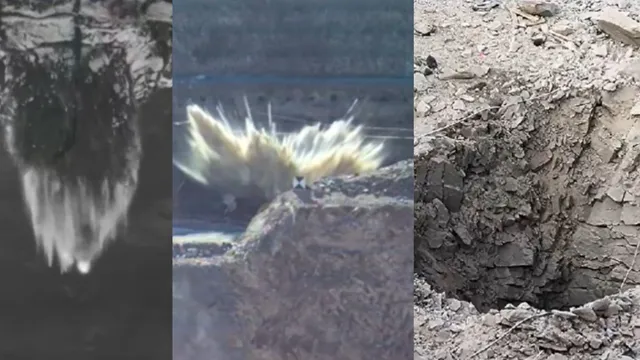- By Supratik Das
- Fri, 27 Jun 2025 08:40 AM (IST)
- Source:JND
During a high-level Pentagon press briefing on Thursday, US Defence Secretary Pete Hegseth and Joint Chiefs of Staff Chairman Gen. Dan Caine shared new information and released test video footage of the recent US missile strikes against Iranian nuclear sites. The attack, carried out using advanced bunker-buster bombs, targeted the destruction of the most key areas of Iran's subterranean nuclear system. The Pentagon released dramatic test videos of the GBU-57 A/B Massive Ordnance Penetrator (MOP) 30,000-pound bunker-buster bomb in order to deny allegations that the attack was of limited impact. The bombs were designed specifically over more than 15 years to attack deeply buried nuclear facilities such as Iran's Fordo enrichment plant. “The footage you’re seeing is the result of hundreds of test shots on mock models. The level of precision and destructive force is unmatched,” said Gen. Caine. He confirmed that 12 of these bombs were dropped on Fordow, with additional strikes on Natanz and Isfahan.
Fordow: Primary Target of Precision Strikes
As described by Gen. Caine, the Fordow facility, which had been in operation since 2009 and was deep inside a mountain, was the primary target. All six ventilation channels, key entry into the buried underground facility, were attacked with six bunker-buster bombs. The sequence of strikes included the initial bomb removing the concrete slab, then four bombs penetrating the shaft at more than 1,000 feet per second, and a sixth as an insurance policy. "Detonation verification was seen. The rear bombers reported the most vivid explosion of their lives—it was daylight-like," Caine added.
Pentagon releases test footage showing how bunker-busters work.@SecDef Hegseth: “Because of the hatred of this press... your people are trying to leak & spin that it wasn't successful. It's irresponsible.” Gen. “Razin” Caine, on the mission: “I have chills..talking about this.” pic.twitter.com/nS1q6ml7Ae
— The White House (@WhiteHouse) June 26, 2025
Pentagon's confidence in the success of the mission comes in the wake of reports by the Defense Intelligence Agency (DIA) that the attacks could have delayed Iran's nuclear program by a couple of months. Hegseth dismissed the report as a "low-confidence assessment with information gaps," claiming instead that the operation was "obliterating, decimating, use your word." Accusing the local media of sabotaging the success of the operation, Hegseth stated, "Due to the antipathy of this press… your people are attempting to leak & spin that it was not successful. It's irresponsible."
15-Year Mission Behind the Bombs
The GBU-57 was developed in 2009, when the US Defense Threat Reduction Agency determined Iran's Fordo site posed a significant threat. They have been conducting decade-long simulations and supercomputer modelling by teams of scientists and engineers to create a bomb that can penetrate Fordow's mountainous defenses. "We stealthily became the largest consumer of supercomputing time in the United States," Caine said, referring to the enormous scientific effort put into the weapons. Although the Fordow facility was the primary target, two penetrator bombs were also targeted at Natanz, and one missile fired from a Navy submarine hit Isfahan. However, Pentagon officials refused to provide details of these second-string strikes. When questioned regarding the 880 pounds of enriched uranium that Iran was said to have in storage at Isfahan, Hegseth responded, "We're taking a look at all elements of intelligence and ensuring that we get a feel for what was where."
While the Pentagon is assured, questions still exist regarding whether Iran had relocated its stock of highly enriched uranium prior to the attack. Hegseth would not confirm whether the uranium was destroyed. “I’m not aware of any intelligence that I’ve reviewed that says things were not where they were supposed to be, moved or otherwise,” he said.

